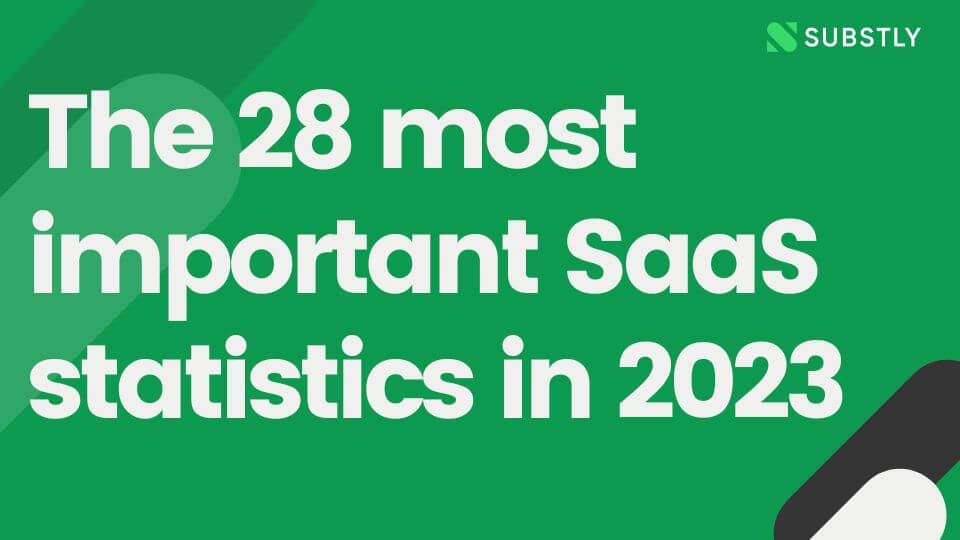Table of Contents
Market size & growth
1. SaaS is considered the most important technology for business success- 2. SaaS solutions will be dominant in all types of businesses soon
- 3. The SaaS market is worth $195 billion in 2023
- 4. The SaaS market is expected to reach $1299 billion by 2030
- 5. There are more than 70.000 SaaS businesses worldwide
- 6. The 20 largest SaaS companies are worth $1,143 billion combined
- 7. Top SaaS businesses grew 62,1% in 2022
- 8. 73% of all SaaS companies were founded after 2010
- 9. More than half of all SaaS companies employ less than 11 people
-
Security & Compliance
- 10. IT security market's forecasted annual growth rate - 19% next five years
- 11. 5x higher risk for cyber incidents without SaaS centralization
- 12. 51% of companies report a rise in cyber attacks after the Covid pandemic
- 13. 25% of former employees have access to company data
- 14. Top priority for IT: fostering stronger IT-Business collaboration
- 15. 40% of companies plan to centralize SaaS management by 2027
- Usage and shadow IT
- 16. 53% of all licenses given out stay unused
- 17. Only 1/3 of SaaS solutions in use are known by IT
- 18. The number of SaaS apps increased by 20-40% YoY
- 19. SaaS apps per department grew by 27% between 2022 and 2023
- SaaS (over)spending & rates
- 20. SaaS spend is at $9,643 per employee and year
- 21. 91% of IT pros say their company is overspending on SaaS products
- 22. Companies without centralized visibility on SaaS overspend by at least 25%
- 23. SaaS prices have increased by 23% compared to 2022
- 24. 38% gap in MRR growth depending on the pricing structure
- 25. Conversions to paying customer triples with credit card-required free trials
- Artificial intelligence and SaaS
- 26. 44% of companies increase productivity through AI
- 27. 74% of technology decisions are backed by AI support
- 28. AI software revenues to reach nearly $100 billion in 2025
- Bonus: The Story of SaaS Market Growth: From Start to Stardom
- Bonus: Why SaaS Market Growth Matters - Changing the Game for Businesses
Hey there, fellow tech enthusiast!
If you're as excited about Software as a Service (SaaS) as we are, you're in for a real treat.
Join us as we unpack the juiciest SaaS stats of the year.
SaaS is at the heart of everything from changing business landscapes to how we binge on software tools.
We've rounded up 28 must-know statistics that spill the beans on adoption trends, market quirks, and how SaaS is basically remodeling the digital realm.
So, if you're curious about the digits driving SaaS's journey, stick around – we're about to dive in and geek out!
1. SaaS is considered the most important technology for business success
In the ever-changing world of technology, Software as a Service (SaaS) has become a game-changer, reshaping how businesses operate, collaborate, and innovate.
As we navigate through 2023, the SaaS industry is thriving, showing growth, innovation, and flexibility to meet the needs of organizations worldwide.
From its small beginnings, SaaS has grown into a powerful force, changing industries and redefining how businesses work in recent years.
The numbers reveal the story of digital transformation, remote teamwork, and the quest for better efficiency for the past decade.
Just how important is SaaS for business success?
Actually, SaaS is THE most important technology for success, closely followed by big data.
A recent survey with 73% of 1,724 respondents saying SaaS is important to them confirmed this.
Breaking it down, 38% believe SaaS is "very important," and 35% think it's "quite important" for their business.
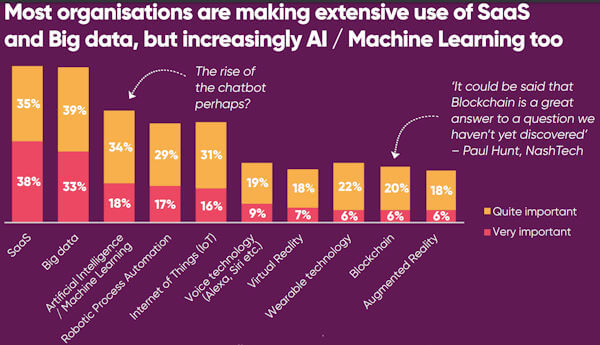 Source: Harvey Nash Group
Source: Harvey Nash Group
2. SaaS solutions will be dominant in all types of businesses soon
Another exciting trend in the SaaS software statistics space is that SaaS is quickly becoming the go-to way for companies to use software.
The old way of buying and managing software is fading.
Instead, SaaS solutions are taking over because they're more flexible and cost-effective.
Businesses of all kinds turn to SaaS to change how they work. In 2022, 50% of all software was SaaS products, expected to reach a market share of 70% by 2026.
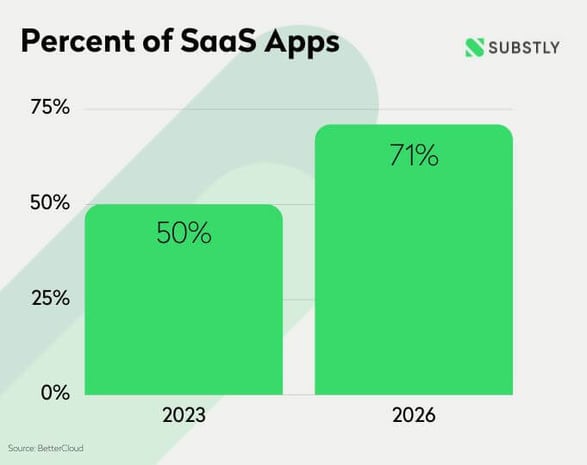
In the next parts of this post, we'll dig into the SaaS statistics and trends, giving you a clear picture of how SaaS is transforming businesses.
Together, we'll see how SaaS isn't just a tool; it's a driving force pushing businesses toward success, efficiency, and new ways of thinking.
3. The SaaS market is worth $195 billion in 2023
Did you know the SaaS industry value is around $195 billion?
Yep, according to the folks at Gartner, that's the deal. But wait, there's more! Back in 2015, the SaaS market size was just $31.4 billion.
Fast forward to 2022, and it shot up to a whopping $167.1 billion.
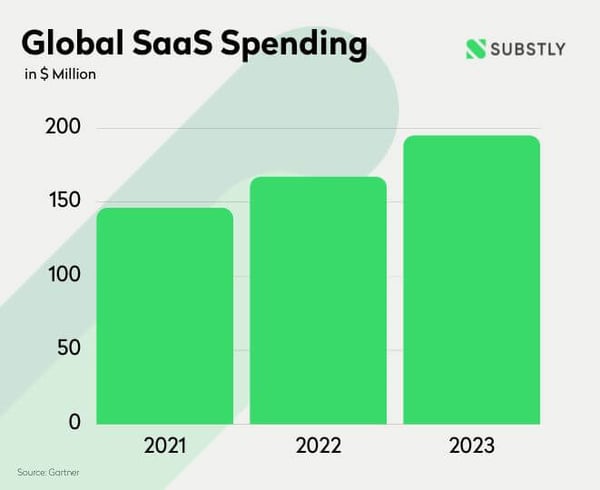
That's like growing five times bigger in just seven years!
And guess what? The party's not stopping.
Experts predict that between 2022 and 2023, the SaaS space will hit a new high, landing at around $195.2 billion by the end of the year.
In the wild world of 2023, the SaaS market's growth isn't just about numbers—it's reshaping how businesses do everything, from how they work to how they thrive.
It's like the spark behind the scenes, making major markets and the business world more connected and collaborative than ever.
4. The SaaS market is expected to reach $1299 billion by 2030
And guess what's on the horizon?
Brace yourself because, in 2030, the Global SaaS Market is expected to reach a mind-blowing value of $1299 billion.
That's some serious growth, with a CAGR of 19.7% from 2023 to 2030, as SkyQuest Technology predicts.
.jpg?width=600&height=572&name=Global%20SaaS%20Market%202021-2027%20(SkyQuest).jpg) Source: SkyQuest
Source: SkyQuest
What is driving this immense growth?
Nothing but a total game-changer in how businesses use technology. Imagine this: SaaS solutions let even small companies access fancy software tools that used to be just for the big players.
Before, only the giants with huge IT budgets could afford them.
But now, thanks to SaaS, even the little guys can get their hands on cutting-edge apps through subscriptions.
This fair playfield created by SaaS software means that startups can take on the big dogs and spark innovation across the board.
And the best part?
You don't need to shell out a bunch of money upfront for software licenses. SaaS uses a subscription model, so it's a smart choice for businesses looking to save costs.
SaaS is like the superhero of the work world, adjusting to the new ways we're working.
With remote work and teams scattered around the globe, SaaS products make it a breeze for people to work together, no matter where they are.
This flexibility became super handy when the world was hit with events that pushed everyone into remote work mode.
But there's more!
The data that SaaS tools generate is like gold for businesses.
It shows how users behave, how things work, and where improvements are needed.
This data-driven approach has changed how businesses plan and do things, leading to happier clients and smoother operations.
So there you have it—a whirlwind tour of how SaaS is changing the game, how it's growing like crazy, and how it's not planning to slow down anytime soon.
Grab your digital popcorn because the show's just getting started!
5. There are more than 70.000 SaaS businesses worldwide
When Vainu looked at the number of SaaS businesses in a recent study, they found about 175,000 companies.
But when they got pickier and only chose the ones their model was super sure about, they ended up with roughly 72,000 companies.
Here's the cool part: Around half of those 72,000 SaaS companies are in the top 10 million websites worldwide for website traffic.
And get this: there are over 1 billion websites out there!
So, that means 50% of SaaS companies are part of the most popular 1% of websites.
SaaS is totally the cool kid on the internet block right now.
Other sources of SaaS software statistics state around 30,000 SaaS companies worldwide.
And guess what? No matter the number of companies, the United States totally takes the lead with a whopping 57% of these companies.
It's like the SaaS capital!
Then you've got the United Kingdom and Canada in second place with about 6.5% each.
And behind them are Germany, France, and India, each with 3%.
Here's the breakdown by country:
- United States (56,7%)
- United Kingdom (6.7%)
- Canada (6,7%)
- Germany (3,3%)
- France (3,3%)
- India (3,3%)
- China (2,4%)
- Brazil (2,2%)
- Australia (2,1%)
- Spain (1,7%)
- Israel (1,6%)
- Netherlands (1,3%)
- Singapore (1,1%)
- Sweden (1,0%)
- Ireland (0,9%)
- Other countries (5,8%)
Oh, and the SaaS scene in the United States?
It's valued at a massive $108.4 billion.
But wait, there's more! They're saying it could reach $225 billion by 2025.
The United States is totally owning the SaaS game, no doubt about it.
6. The 20 largest SaaS companies are worth $1,143 billion combined
A rundown of the heavyweights that are making waves across continents found the following companies are the largest based on their market capitalization or estimated valuation.
Salesforce: Pioneering Customer Relationships ($183.80 billion)
Kicking off the list is Salesforce, the trailblazer in customer relationship platforms. Their innovative software empowers businesses to orchestrate marketing campaigns and glean invaluable analytics.
Adobe Inc: Crafting Digital Experiences ($158.87 billion)
Next up is Adobe, a digital magician catering to diverse needs – from businesses to content creators. Their suite of software products is driving digital transformation.
Intuit: Mastering Business Operations ($115.78 billion)
Intuit takes the spotlight with its cloud software platform that streamlines payroll management, financial exploration, and various other business operations.
ServiceNow: Revolutionizing Cloud Computing ($90.54 billion)
ServiceNow steps in with its game-changing cloud computing offerings, incorporating AI and workflow automation to elevate business processes.
Shopify: Empowering Commerce ($55.51 billion)
Empowering merchants across the globe, Shopify's commerce-focused SaaS platform revolutionizes product marketing, inventory management, and financial security.
And the list goes on, featuring juggernauts like Workday, Block, Snowflake, Roper Technologies, and Atlassian, each with distinctive prowess in shaping the SaaS landscape.
Companies like Zoom, Hubspot, and Datadog also earn a spot at the end of the list.
Other market leaders like Microsoft, Oracle, Google, and Slack didn't, for some reason, make their list.
7. Top SaaS businesses grew 62,1% in 2022
Things slowed slightly in 2022 compared to the crazy growth in 2020 and 2021.
According to Chartmogul, the top SaaS businesses with an ARR between $1 and $30 million grew 62.1% in 2022.
Sure, it's a bit less than the largest increase of 93.4% in 2020 and 78.9% in 2021, but hey, still pretty impressive.
They studied over 2,100 SaaS businesses to figure that out.
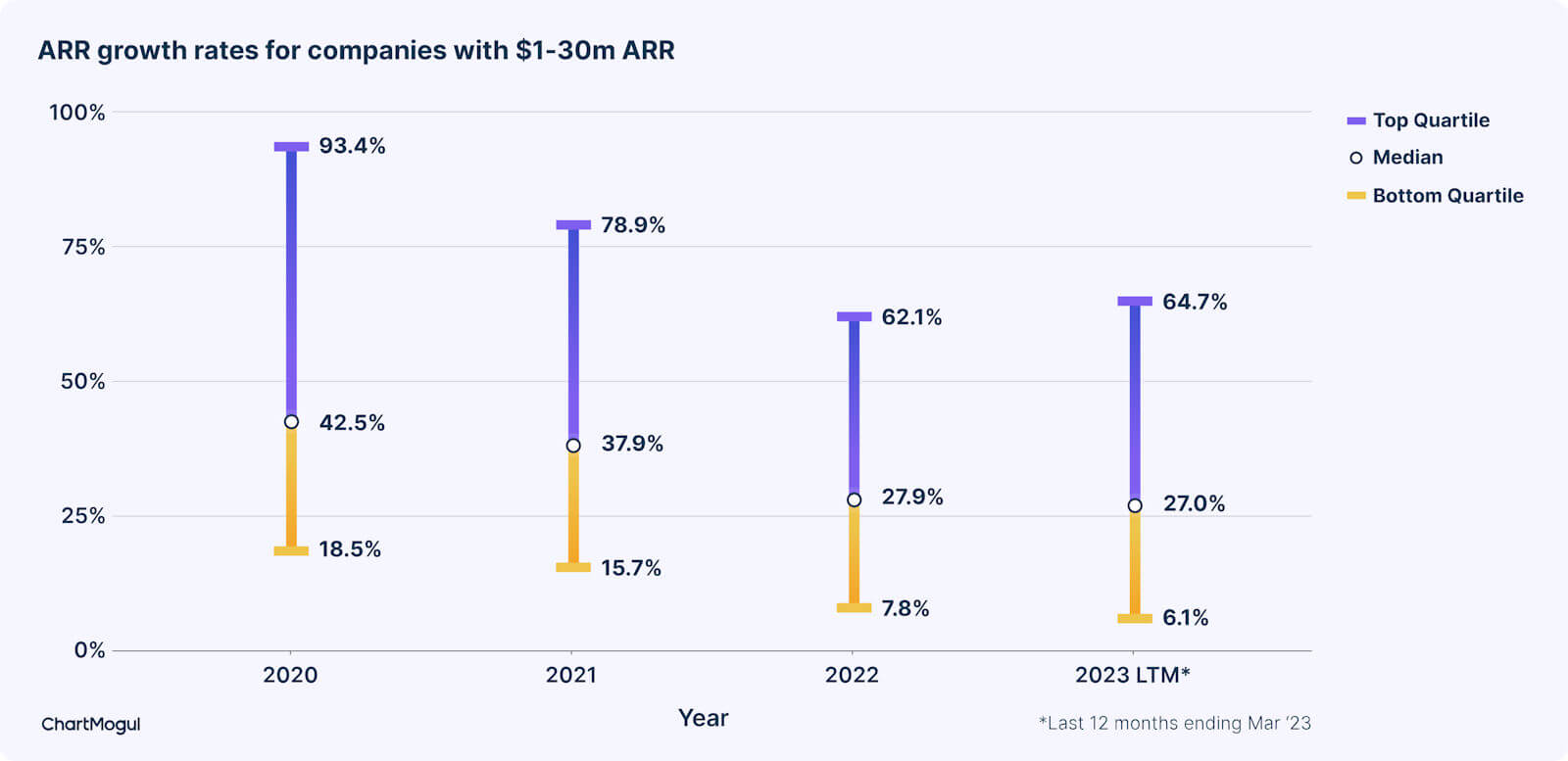 Source: ChartMogul
Source: ChartMogul
8. 73% of all SaaS companies were founded after 2010
No big surprise, but SaaS companies are pretty darn new.
About 73% of all SaaS companies came into existence after 2010.
Check out the graph – there are a couple of real oldies, but they didn't start out as SaaS champs.
They jumped on the SaaS train later and are now in the SaaS club.
But most companies?
They're fresh faces, with a whopping 93% of SaaS companies, not even around 2000.
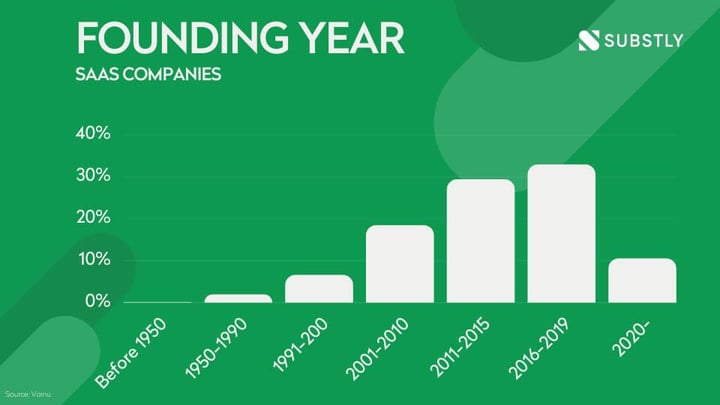
9. More than half of all SaaS companies employ less than 11 people
So, Vainu also found that over half of these SaaS companies are pretty small, with less than 11 people working there.
But here's the kicker: while everyone's all hyped about those huge unicorn companies, you've got to know that about 90% of SaaS vendors are actually these micro or small businesses with less than 50 employees.
They're the real heart of the SaaS scene, even if they don't get all the spotlight.
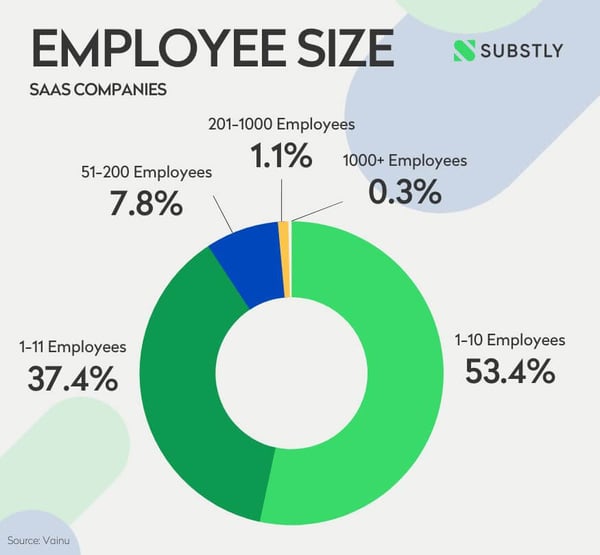
Things get interesting when we look at the company size in different industries.
For instance, two-thirds of Lead Generation, Email Marketing, and Project Management businesses are these tiny "micro" teams, coming in at around 67.7%, 65%, and 64.8%, respectively.
But when it comes to fields like Security, Virtual Reality, and Payroll, only about a third of the companies (around 28.4%, 31%, and 32.2%) fall into the 1 to 10 employees range. It's a real mix out there!
Security & Compliance
10. IT security market's forecasted annual growth rate - 19% next five years
According to Mordor Intelligence, IT Security is expected to grow from USD 24.31 billion in 2023 to USD 57.49 billion from 2023 to 2028.
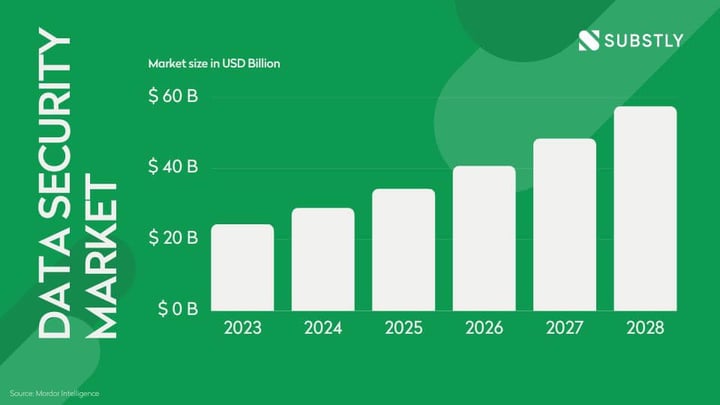
The reasons for this growth?
Think about how much data we're creating these days – all thanks to going digital and those smart devices we use.
But hey, with all this data flying around, it's important to ensure it's all safe and sound. And guess what?
These cyber shenanigans are costing a mind-boggling $600 billion every year! No wonder everyone's shouting for better security.
Regulations like GDPR have placed strict requirements on businesses to safeguard their systems against breaches.
So, what does that mean? Yep, even more demand exists for tools that keep our data on lockdown.
Data Auditing, Real-time Alerts, and Data Risk Assessment are now our superhero squad against breaches.
But, of course, there's a catch – spotting sensitive data and money issues can still trip us up, especially for startups and small fries.
11. 5x higher risk for cyber incidents without SaaS centralization
In a world that's all about being connected and digital, security breaches pack a powerful punch.
They can destroy a business's bottom line and even tarnish its reputation.
Gartner, the guru of tech insights, has sounded the alarm about security in an article on the SaaS management platform market.
They're telling organizations that if they don't start managing their SaaS life cycles centrally, they're opening the door to trouble.
In fact, Gartner warns that these organizations become five times more likely to face cyber attacks or the dreaded data loss.
It's like leaving the front door unlocked and wondering why the burglars came in.
12. 51% of companies report a rise in cyber attacks after the Covid pandemic
2021 was a wild ride, especially for cyber attacks. After the pandemic hit, there was a cyber storm brewing.
According to a survey by Harvey Nash, where they chatted with 1,724 tech wizards from 69 countries, the shocking truth came out.
More than half of all organizations saw a rise in cyber attacks.
It's like the bad guys saw the chaos and thought, "Let's make things worse."
Think of data like gold in the digital era, and SaaS apps are like vaults protecting tons of valuable corporate and personal information.
SaaS's design improves cloud security. By centralizing data storage and management, SaaS platforms can stick to one set of security rules.
That means no more risky business due to inconsistent practices across different systems.
Businesses can focus on their core stuff instead of sweating about each software's security.
13. 25% of former employees have access to company data
SaaS security isn't just about playing defense; it's about giving businesses the confidence to go big on digital transformation.
When a company knows its data is locked down tight, it's more likely to plunge into new tools and strategies that supercharge growth.
But with more tools comes yet another challenge.
You might think employee off-boarding is a simple "goodbye," but it's more than that. It's about cloud security, too.
Brace yourself: a whopping 60% don't get off-boarded right away.
They're like the party crashers who stay long after everyone leaves.
And if that's not jaw-dropping enough, 25% hang around unattended, even a week after they've left the company.
It's like the digital version of leaving a window open after you've moved out.
14. Top priority for IT: fostering stronger IT-Business collaboration
Tech and business teams often feel like two different worlds.
But guess what? IT is making an effort to be friends.
At least 24% of them are on a mission over the next 12-18 months, as stronger collaboration with other departments is their top priority.
They're building bridges between tech and business departments to enhance data security and streamline operations.
It's like throwing a big party to introduce two groups of friends who've never met.
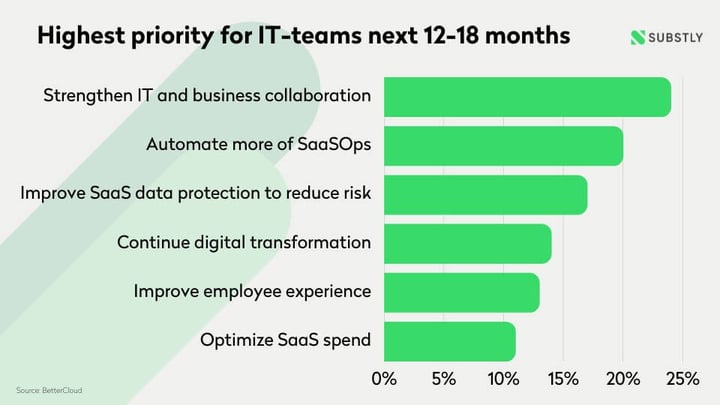
15. 40% of companies plan to centralize SaaS management by 2027
Picture this: companies using multiple SaaS apps running around like headless chickens.
But wait, there's hope on the horizon!
Gartner has a prediction, and it's a game-changer.
By 2027, they say 40% of these companies will finally gather their wits.
They'll centralize their management using SaaS management platforms. It's like going from chaos to calm, all thanks to smart planning.
This is a big jump from the less than 25% who did it in 2022.
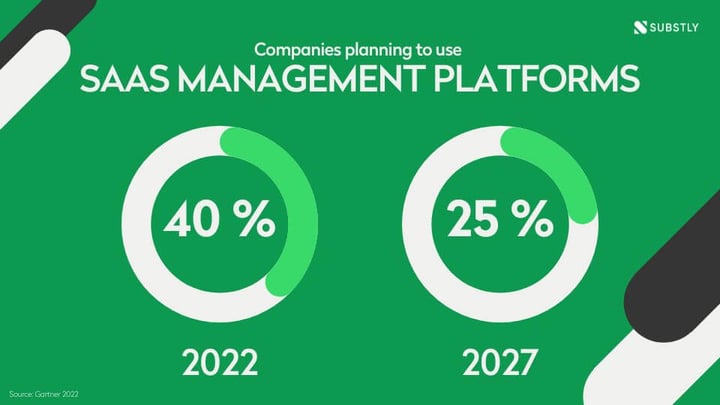
Usage and shadow IT
16. 53% of all licenses given out stay unused
Think of SaaS as your superhero toolbox, filled with apps for all your needs.
From handling projects to keeping customers happy, SaaS solutions are your versatile buddy.
It's like having a pick 'n' mix of tools that make work smoother and faster.
Unfortunately, there is still a lot of work to ensure you get a positive ROI (the good stuff a business gets from its investments).
Businesses of all sizes have slightly increased license adoption between 2021 and 2023, but 53% of licenses remain unused.
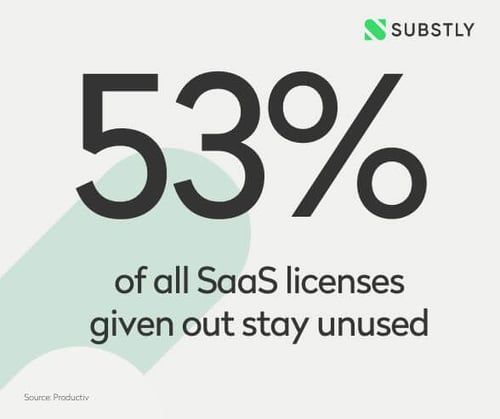
17. Only 1/3 of SaaS solutions in use are known by IT
Now, let's talk about the lack of visibility, aka the mysterious Shadow IT.
Imagine folks in the company using software that's not on the approved list.
Sounds harmless, right?
But here's the twist: It can mess up security, create tech tangles, and even break compliance rules.
It's like having secret agents doing their own thing, and nobody's watching them.
But guess what?
A whopping 65% of SaaS apps used are totally off the IT radar. And Gartner, the tech experts, found out that IT usually knows only about one-third of the SaaS apps folks are using.
Yep, that's right, Shadow IT is like the ninja of software sneaking around.
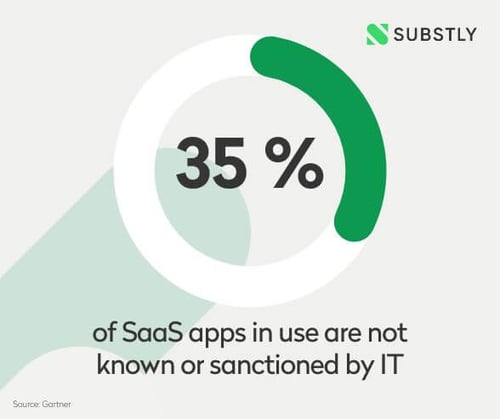
Now, here comes the tricky part.
You want innovation to bloom, but you must also keep the total company software use under control.
It's like riding a seesaw—up for creativity, down for rules.
You don't want to crush folks' ideas, but can't let things go haywire.
18. The number of SaaS apps increased by 20-40% YoY
Did you know that SaaS apps have been popping up like popcorn in the last five years?
A survey by BetterCloud among 734 IT and security professionals found that they've grown 20%-40% yearly in recent years!
But here's the kicker: Shadow IT is still a big player, covering more than half the apps in most SaaS lineups.
19. SaaS apps per department grew by 27% between 2022 and 2023
The number of SaaS apps per department grew by a whopping 27% between 2022 and 2023, states Productiv.
Engineering is leading the race with the most apps.
IT & Security is another contender, growing 33%—they're diving into special tools and apps to boost ROI (that's the good stuff a business gets from its investments).
And guess what?
Customer Success also stepped up, realizing that keeping clients happy is the secret sauce.
So, here's the deal: SaaS is an adventure, and Shadow IT is like the quirky sidekick.
Embrace the power of choice, tackle the sneaky stuff, and prepare for the ride.
It's all about balancing innovation, keeping tabs on Shadow IT, and making the most of the SaaS revolution.
SaaS (over)spending & rates
20. SaaS spend is at $9,643 per employee and year
Ah, the world of SaaS spending—a realm where investments promise growth but often lead to overspending.
As businesses sprint ahead in the digital race, managing SaaS costs becomes a strategic tightrope walk, with every dollar spent needing to align with the value gained.
Investing in SaaS tools is like adding tools to a toolkit, but it's not always smooth sailing.
On one side, SaaS apps streamline operations, boost productivity, and drive innovation.
They're the superhero capes that make businesses fly.
But here's the twist:
These tools can contribute to overspending without careful monitoring.
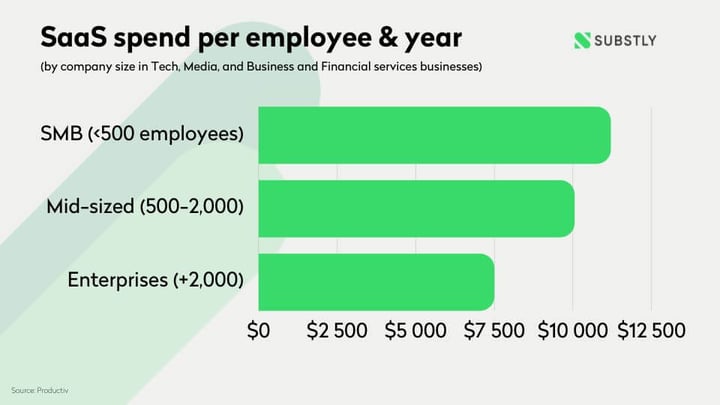
Did you know that Tech, Media, and Business and Financial services organizations are forking out an average of $9,643 per employee on SaaS?
However, the size of the company plays a tune with these numbers.
Small and medium-sized businesses (SMBs) with fewer than 500 employees are shelling out $11,196 per person yearly.
Mid-sized companies (500-2,000) are spending $10,045, and enterprises with 2,000+ are more frugal, spending $7,492 per person.
The bigger the company, the smaller the spending—thanks to discounts, licensing deals, and efficiency gains.
21. 91% of IT pros say their company is overspending on SaaS products
It's like getting more ingredients than you need for a recipe.
Despite the hype, many businesses are guilty of overloading their toolkit with unused licenses.
The stats don't lie—between 2021 and 2023, license adoption saw a slight bump, yet a staggering 53% of these licenses remained unused.
It's like buying a whole cake and only eating a slice.
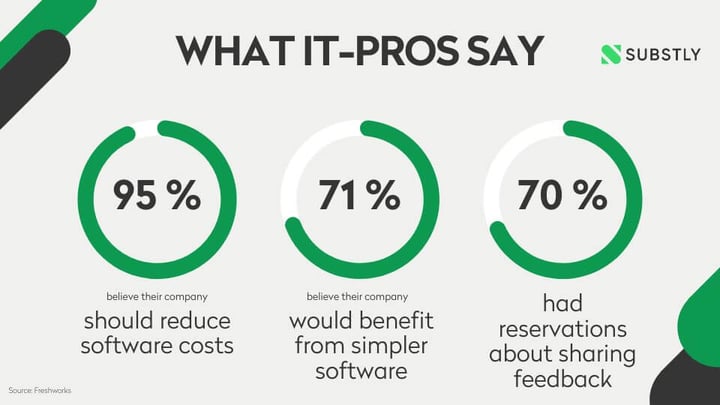
The State of Software at Work survey by Freshworks in 2022 revealed some eye-opening SaaS software statistics.
In a global survey among 2001 IT professionals, a whopping 95% said their company could benefit from reducing overall software contracts.
And guess what? 71% believed their company would benefit from simpler software.
But here's the catch—70% had reservations about sharing feedback.
Some didn't want to be seen as complainers (21%), others felt their feedback would be ignored (21%), and a good chunk (17%) doubted if they'd be listened to.
22. Companies without centralized visibility on SaaS overspend by at least 25%
Ever heard the saying, "You can't manage what you can't see"?
Well, it's bang on when it comes to SaaS spending.
To keep those dollars in check, you must know what apps are in play, who's using them, and how often.
Think of it as having a dashboard that lets you watch your spending live, ensuring every dollar is used wisely.
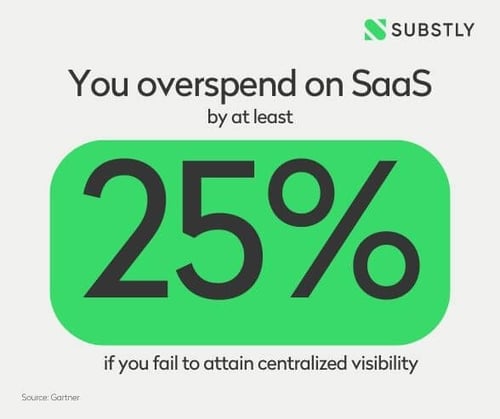
Here's the scoop:
Companies that don't get a grip on centralized visibility tend to overspend on SaaS by at least 25%, Gartner states in a recent study.
It's like having a treasure map, but missing the "X marks the spot."
Centralized visibility is the key to keeping that budget in check.
23. SaaS prices have increased by 23% compared to 2022
There's been quite a buzz that SaaS fees are gearing up for a 2023 lift.
Why?
Well, picture a tougher economic landscape and rates sneaking up due to inflation.
Big shots like Google, AWS, and LinkedIn might nudge their price tags higher.
They're like that cool club everyone wants to join, and if they jack up their fees, where else will you get your groove on?
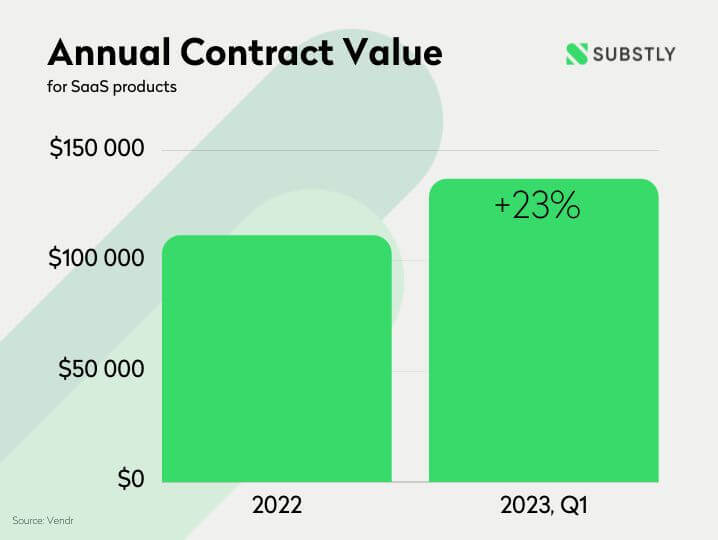
Hold onto your hats – the Annual Contract Value (ACV) for SaaS goodies rocketed to $137,072.
That's a major leap from the previous years, a whopping 23% jump from 2022's ACV.
And here's the kicker – federal interest rates hitched a ride up by four percentage points between March 2022 and March 2023.
This was basically holding hands with the steady rise in the average contract value (ACV) of SaaS purchases over the past 12 months.
24. 38% gap in MRR growth depending on the pricing structure
Picture this:
A virtual battlefield where pricing structures duke it out for startup supremacy.
A survey rallied 493 bootstrapped startup founders from MicroConf's network, revealing the true impact of free trials on growth—depending on the pricing structure they're paired with.
In this showdown, the best pricing structure triumphed over the worst by a whopping 38%.
And here's where it gets interesting: annual and monthly subscriptions flexed their muscles with free trials, while meter pricing and pay-as-you-go thrived sans a free trial.
Check out these stats:
Annual subscriptions swaggered in first, boasting an average MRR increase of $1,204. Monthly subscriptions followed closely with $1,017, while Metered pricing stood at $839. Pay-as-you-go, however, took a bit of a backseat with an average increase of $749.
So, what's the real magic behind these pricing tactics?
Drumroll, please.
Here's how much MRR the different business models added per month, with and without free trials:
- Annual Subscriptions: With a free trial, it's $1,259 MRR (sans free trial: $1,148 MRR).
- Monthly Subscriptions: Flexing with a free trial, it's $1,074 MRR per month (or $960 without).
- Metered Pricing: Bringing in $660 MRR monthly when paired with a free trial (and $1,017 without).
- Pay-as-you-go: With a free trial, it's $739 MRR monthly (or $758 without).
And what do you think was the leading startup model?
According to the same study, 66% offered a free trial, and 17% had gone with a free forever plan.
25. Conversions to paying customer triples with credit card-required free trials
Ah, free trials—the tease before the commitment.
But here's the kicker:
the conversion to a paid plan triples if a credit card is required for the trial.
Yup, you heard that right. The conversion rate is 10-15% when no credit card is needed.
Flip the script and ask for a credit card.
Bam! The conversion rate rockets to 30-39%.
It's like waving a magic wand of persuasion (however, the survey didn’t answer how this affects churn rates).
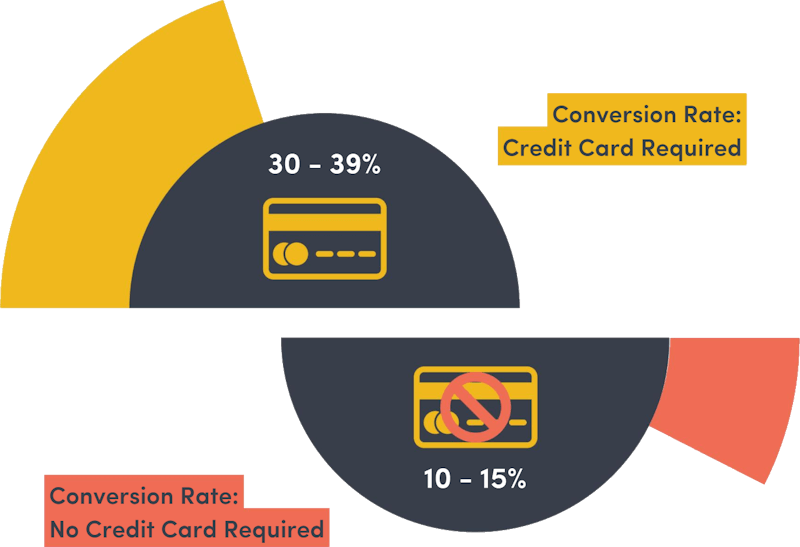
Source: MicroConf
So, there you have it—the dance of pricing strategies, where free trials and credit card requirements play a vital role.
As startup warriors juggle numbers and test tactics, the lesson is clear:
Pricing isn't just a number; it's the key to unleashing growth and winning the startup game.
The battle's fierce, but armed with insights, every startup can find their pricing victory.
Artificial intelligence and SaaS
26. 44% of companies increase productivity through AI
PWC’s most recent AI Business Survey is about how 1,000 business and tech leaders in the US use AI in their companies.
They found that companies doing AI in a smart and all-around way do better than those doing it in bits and pieces.
Those companies also get way more value from AI, improving things like decision-making, customer experience, productivity, and product and service innovation.
Here are the five top answers from the surveyed leaders about where and how substantial AI value is realized in the business:
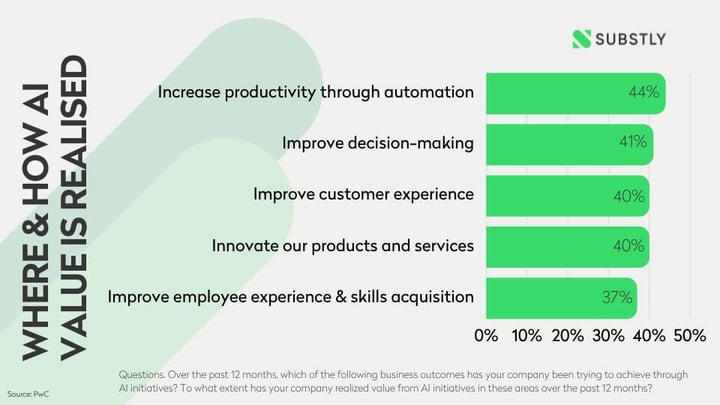
27. 74% of technology decisions are backed by AI support
AI can help companies make choices by using lots of info that people can't do alone.
For example, it can help set rates by looking at old sales, costs, and what clients like.
It can also guess what other companies might do. With AI and sensors, they can predict when machines need help, and it can all happen in an instant.
At the beginning of 2022, 1,000 business leaders and technology executives were asked by PWC what types of business decisions their company would use AI to support.
Below is a visualization showing the top five areas and the forecasted extent.
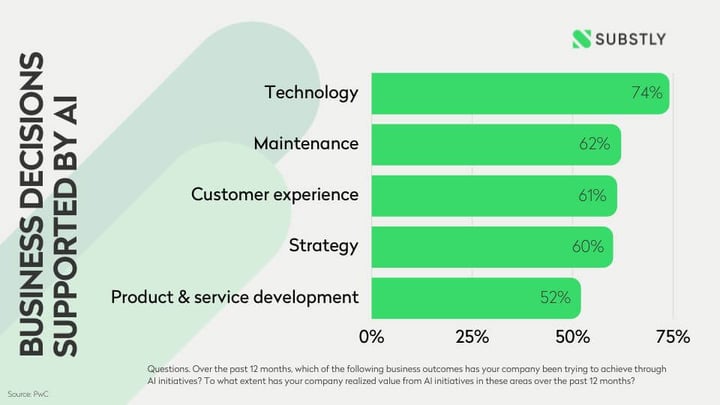
PWC was also kind enough to provide a few tips for companies starting out with using AI:
- Starting with What You Want - When thinking about using new fancy AI tricks to make decisions, don't start by staring at your data. Nope, start by thinking about what you actually want to achieve in your business. Your end goal! Once you've got that, then you can go hunting for the right data and numbers to back up your plan. Think about who's going to use this AI magic to get things done, where it fits in your decision-making process, how it's going to work with the cloud, and how you're going to keep an eye on it, make it better, and eventually give it a break.
- Let AI Do the Heavy Lifting with Your Data - After you figure out what data you need, let AI be your superhero sidekick in finding and using it. Seriously, many companies are swamped with messy, unorganized data. But guess what? AI can dive into this data ocean, fish out exactly what you need, and put it right in front of the right folks at just the right time.
- Small Steps, Big Wins - A full-on, all-at-once approach isn't always the way to go. Especially when things get tricky; let's say you're dealing with something big, like how your company impacts the environment. Start small, like checking out how much carbon your one building emits. Once you've got that down, you can crank it up and look at other buildings and all those environmental factors.
28. AI software revenues to reach nearly $100 billion in 2025
You won't believe the AI market's future – it's like a rollercoaster ride!
Statista writes that the worldwide market revenue for AI is forecasted to grow significantly from 2018 to 2030, although different studies suggest variations in just how much the global market size will increase.
IDC says we're talking about over $500 billion by 2024.
But hold onto your hat because Precedence Research thinks it will balloon to a whopping $1.5 trillion by 2030.
The AI software market's global annual revenue is over $50 billion now and is expected to reach nearly $100 billion in 2025, according to Omdia.
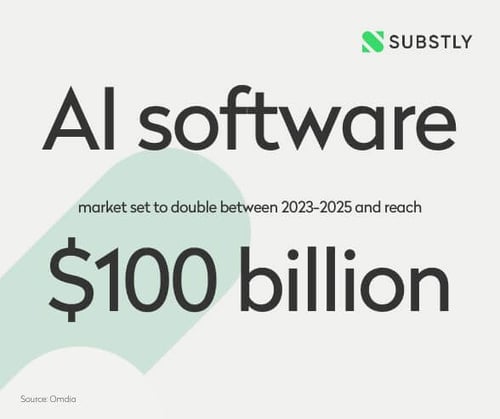
Bonus: The Story of SaaS Market Growth: From Start to Stardom
Let's take a trip down memory lane and see how Software as a Service (SaaS) went from an idea to a big deal.
In the early 2000s, folks were beginning to wrap their heads around the idea of getting software over the internet.
But it wasn't until the mid-2000s that SaaS really caught fire.
As internet speeds got better and businesses wanted smarter and cheaper solutions, SaaS stepped in as the cool alternative to old-school software installs.
At the start, some folks weren't so sure about SaaS.
They worried about keeping their data safe and the software staying reliable.
But the early pioneers of the game sorted out those kinks and showed off how awesome cloud-based software could be.
Suddenly, SaaS had everyone's attention. Why? Because it promised lower costs upfront, updates without a hitch, and the power to use apps from anywhere with internet access.
Startups and big shots alike wanted in on this action to make their operations smoother.
Bonus: Why SaaS Market Growth Matters - Changing the Game for Businesses
So, why is the growth of the SaaS market such a big deal?
It's not just some boring number – it's a game-changer in how businesses work with tech.
One of the cool things about SaaS is that it gives even the little guys access to fancy software tools.
Only the big dogs with fat IT budgets could afford those in the old days.
But with SaaS, even small and medium-sized businesses can use top-notch apps on a subscription basis.
This change has shaken things up and let startups go head-to-head with the big players.
It's like a digital David taking on a Goliath.
Plus, SaaS's pay-as-you-go style means you don't need to splash out a ton of cash upfront on software licenses.
That's music to the ears of businesses looking to save some bucks.
SaaS isn't just about the software – it's also about how we work.
With more folks working from home and teams scattered, SaaS tools allow everyone to team up from wherever.
This flexibility was handy during crazy times when the whole world was suddenly working from the kitchen table.
And guess what?
SaaS doesn't just give us cool tools; it hands over a treasure trove of data.
This data helps businesses understand how folks use the software, how things run, and what can be done better.
Armed with this info, businesses can make smarter choices, make customers happier, and run things way smoother.
As we roll through 2023, the SaaS market keeps growing, and it's not just a tech trend anymore.
Nope, it's changing the game for businesses, connecting people worldwide, and making things smoother.
It's all part of this wild ride we call the digital transformation.
So buckle up because SaaS is taking us places we've never been!
References (all sources accessed in Aug 2023)
- Harvey Nash Group Technology & Talent Study 2021, by Harvey Nash Group
- The 2023 State of SaaSOps Report, by BetterCloud
- Global SaaS Market Size, Share, Growth Analysis 2023-2030, by Skyquest
- SaaS Benchmarks Report 2023, by ChartMogul
- Forecast: Public Cloud Services, Worldwide, 2020-2026, 3Q22 Update, by Gartner
- 2022 Gartner® Market Guide for SaaS Management Platforms by Gartner
- State of Saas Trends, by Productiv
- The SaaS Trends report - Q1 2023, by Vendr
- State of Independent SaaS 2022, by MicroConf
- A global study of 70,000 SaaS companies, by Vainu
- PwC 2022 AI Business Survey, by PwC
- Statista's Market size and revenue comparison for artificial intelligence worldwide from 2018 to 2030, by Statista
- 2023 Digital transformation trends, by Omdia
- Data Security Market Size & Share Analysis - Growth Trends & Forecasts (2023-2026) by Mordor Intelligence
If you work in a small or medium-sized business and seek a SaaS management platform with a short learning curve that is user-friendly and strengthens the cooperation between IT and Business, consider exploring Substly on your own or get a personal introduction to see if it suits your needs.
Related articles
SaaS Management: What is it, tips for getting started & best practices

